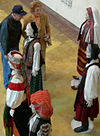Willamette Heritage Center
This article needs to be updated. (January 2015) |
Thomas Kay Woolen Mill | |
 Thomas Kay Woolen Mill from the rear, showing the dye house | |
| Location | Salem, Oregon |
|---|---|
| Coordinates | 44°56′6″N 123°1′37″W / 44.93500°N 123.02694°W |
| Built | 1889 |
| Architect | Walter D. Pugh |
| NRHP reference No. | 73001579 |
| Added to NRHP | May 8, 1973 |
Willamette Heritage Center is a museum in Salem, Oregon. The five-acre site features several structures listed on the National Register of Historic Places including the Thomas Kay woolen mill,[1] the Jason Lee House,[2] Methodist Parsonage,[3] John D. Boon House, the Pleasant Grove (Condit) Church.[4][5] The houses and church were relocated to the mill site. The Center also includes a research library and archives of Marion County history.
The Center was created in 2010 from the merger of the Mission Mill Museum Association (est. 1964) and the adjacent Marion County Historical Society (est. 1950).[6][7]
History
[edit]The Thomas Kay Woolen Mill was started in 1889 by Thomas Lister Kay, whose descendants eventually founded Pendleton Woolen Mills.[8][9] The workforce of 50 labored 60-hour weeks. In 1895, a fire destroyed the mill.[10] Ground was broken on a new mill structure on December 20, 1895, in the same location. This building, designed by architect W.D. Pugh, is the brick structure that stands today. The building opened to the public on May 15, 1896, to speeches, demonstrations and music.[11]
The mill was operated by four generations of Kay family members. Thomas Lister Kay died in 1900 and his son Thomas B. Kay took over as president and served until his own death in 1931.[9] Thomas B. Kay's son Ercel took over for his father, and Ercel's son Tom Kay took over for him.
The mill announced its closure in 1959, and all operations ceased by 1962.[12]
Archeological digs on the northern part of the center's grounds led to the discovery of the site where a Methodist mission school stood before it was destroyed by fire in 1872.[13]
Museum
[edit]Visitors can tour the mill buildings with displays of original 19th and 20th century machinery and photos about industrial wool processing.
The houses and church have been restored and furnished to a mid 19th-century appearance. The Jason Lee House features a special exhibit about early Oregon during the time of the Methodist Mission.
The museum includes a water power interpretive exhibit by Portland General Electric. The exhibit demonstrates how the mill was run using the water from Mill Creek.
Structures
[edit]- Jason Lee House (1841), a home of Jason Lee which, with the Parsonage, are the earliest known frame buildings in Salem, and perhaps the oldest remaining in the state
- Methodist Mission Parsonage (1841)
- John D. Boon House (1847)
- Pleasant Grove Presbyterian Church (1858)
- Thomas Kay Woolen Mill (1889/1896)
See also
[edit]References
[edit]- ^ "Thomas Kay Woolen Mill". Oregon Historic Sites Database. Oregon State Historic Preservation Office.
- ^ "Jason Lee House". Oregon Historic Sites Database. Oregon State Historic Preservation Office.
- ^ "Methodist Parsonage". Oregon Historic Sites Database. Oregon State Historic Preservation Office. Retrieved 18 March 2015.
- ^ "Pleasant Grove Presbyterian Church". Oregon Historic Sites Database. Oregon State Historic Preservation Office. Retrieved 18 March 2015.
- ^ "John D. Boon House". Oregon Historic Sites Database. Oregon State Historic Preservation Office. Retrieved 18 March 2015.
- ^ "Salem in 1973". Salem Heritage Network. June 30, 2010. Retrieved 27 January 2015.
The Mission Mill Museum and the Marion County Historical Society, on the same property, have become united in 2010 as the Willamette Heritage Center.
- ^ "Research & Library". Willamette Heritage Center. Retrieved 27 January 2015.
- ^ Lomax, Alfred (1974). "2:Thomas kay Woolen Mills Company". Later Woolen Mills in Oregon. Portland, Oregon: Binfords & Mort. p. 25. ISBN 0-8323-0238-4.
"On July 16, 1889, the Thomas Kay Woolen Mill Company was incorporated...Thomas Kay, General Manager." Although Thomas Lister Kay is considered the founder of the mill, it was built with capital from the Salem community and overseen by a board of directors made up of stock holders.
- ^ a b Thomas Kay. Salem Online History. Salem Public Library. Retrieved on July 24, 2009.
- ^ Lomax, Alfred (1974). Later Woolen Mills in Oregon. Portland, Oregon: Binford & Morts. p. 37. ISBN 0-8323-0238-4. Retrieved 18 March 2015.
- ^ Lomax, Alfred (1974). Later Woolen Mills in Oregon. Portland, Oregon: Binfords & Mort. pp. 43–45. ISBN 0-8323-0238-4. Retrieved 18 March 2015.
- ^ Lomax, Alfred (1974). Later Woolen Mills in Oregon. Portland, Oregon: Binford & Mort. p. 64. ISBN 0-8323-0238-4.
- ^ Alex, Rachel; Reporter, er-Salem (2022-04-08). "Now underway, mission school excavation yielding more questions". Salem Reporter. Retrieved 2022-06-29.
External links
[edit]- Industrial buildings completed in 1890
- Museums in Salem, Oregon
- Textile museums in the United States
- Historic house museums in Oregon
- Mill museums in the United States
- National Register of Historic Places in Salem, Oregon
- Industrial buildings and structures on the National Register of Historic Places in Oregon
- 1889 establishments in Oregon





